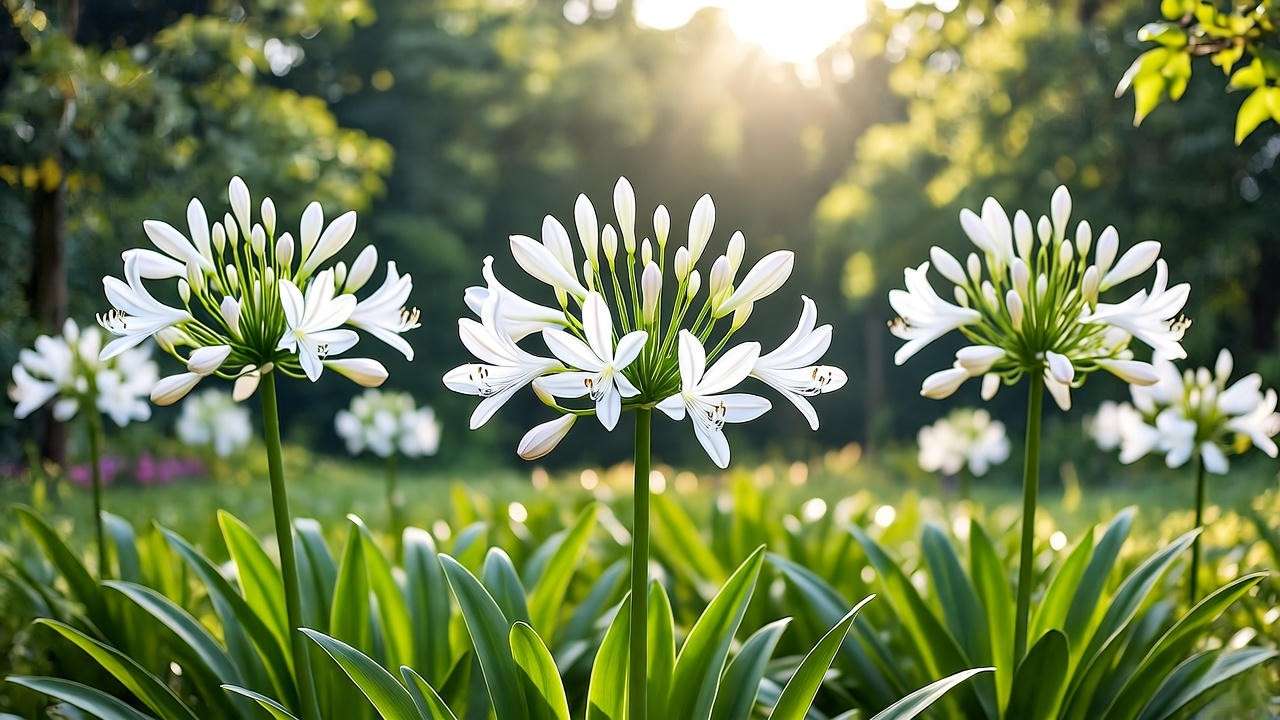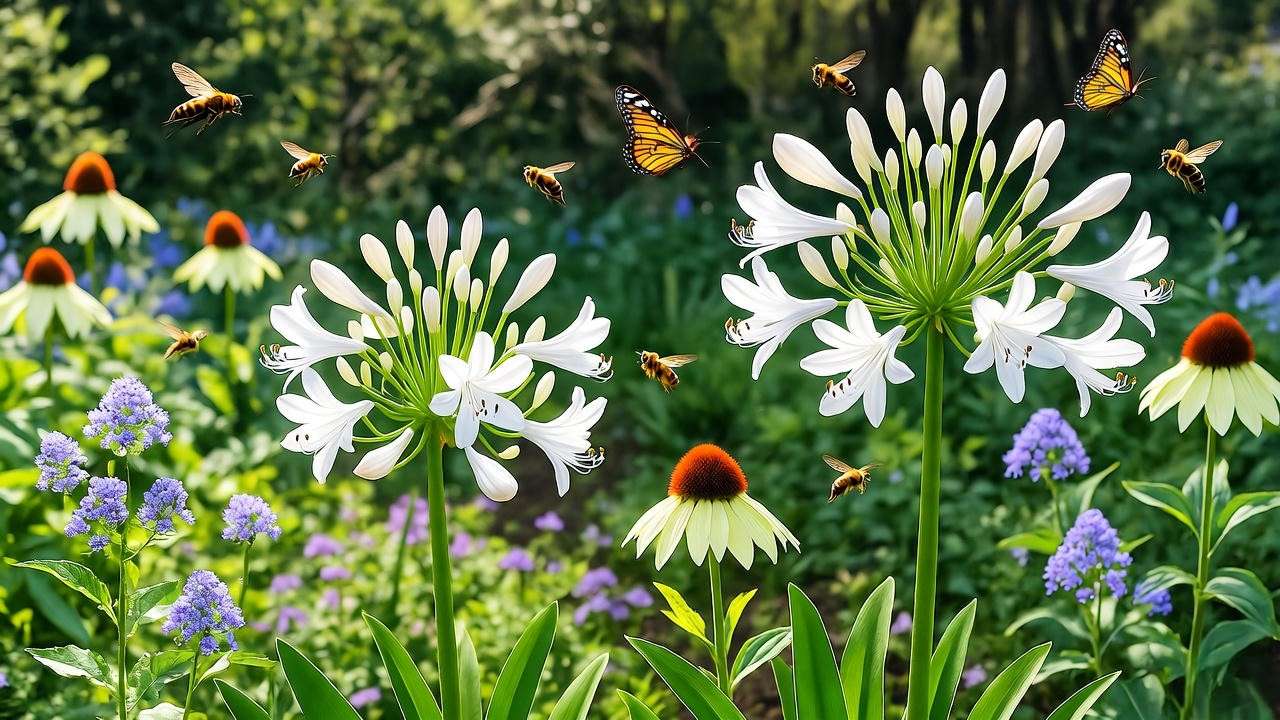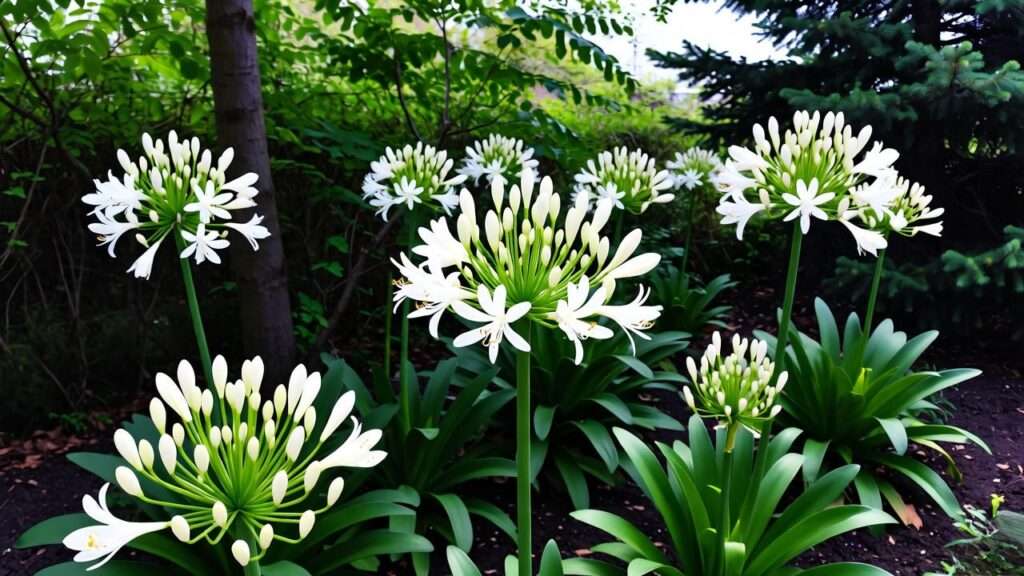Imagine stepping into your garden and being greeted by clusters of radiant white agapanthus plants, their star-like blooms swaying gently in the summer breeze. These elegant perennials, also known as white lily of the Nile, transform any outdoor space into a serene, sophisticated haven. Whether you’re a seasoned gardener or a beginner, growing white agapanthus plants is a rewarding journey that combines low-maintenance care with stunning results. In this comprehensive guide, I’ll share expert tips—drawn from years of horticultural experience and backed by botanical research—to help you cultivate vibrant, healthy white agapanthus in your garden. From planting to pest control, this article covers everything you need to ensure your blooms thrive, whether in borders, containers, or coastal landscapes. Let’s dive in and create a garden masterpiece! 🌼
What Are White Agapanthus Plants? 🌺
Overview of Agapanthus Species
White agapanthus plants, scientifically known as Agapanthus africanus or hybrid cultivars, are beloved perennials celebrated for their trumpet-shaped flowers and lush, strap-like foliage. Native to South Africa, these plants belong to the Amaryllidaceae family and are prized for their ability to thrive in diverse conditions. White agapanthus varieties, such as ‘Albus’ or ‘White Heaven,’ feature snowy blooms that contrast beautifully with their deep green leaves. Unlike their blue or purple counterparts, white agapanthus exude a clean, timeless elegance.
Agapanthus plants come in two main types: evergreen and deciduous. Evergreen varieties retain their foliage year-round, making them ideal for mild climates, while deciduous types shed leaves seasonally and are better suited for colder regions. Understanding these distinctions helps you choose the right cultivar for your garden’s climate and aesthetic.

Why Choose White Agapanthus for Your Garden? 😍
White agapanthus plants are a gardener’s dream, combining beauty with practicality. Their crisp, white blooms create a serene focal point in any landscape, from modern minimalist gardens to lush, traditional beds. These plants are incredibly versatile, thriving in borders, containers, or as standalone features. Their drought tolerance makes them a top choice for water-wise gardening, while their ability to withstand coastal conditions—salty air and windy exposures—sets them apart.
Beyond aesthetics, white agapanthus attract pollinators like bees and butterflies 🐝, boosting your garden’s biodiversity. They’re also low-maintenance, requiring minimal care once established, which is perfect for busy gardeners. Whether you’re aiming for a vibrant summer display or a year-round evergreen accent, white agapanthus deliver unmatched charm.
Key Characteristics of White Agapanthus
- Growth Habits: Clump-forming, typically 2-4 feet tall and wide, with long, arching leaves.
- Blooming Season: Mid to late summer, with flowers lasting several weeks.
- Hardiness: Thrives in USDA zones 8-11; can be grown in colder zones with winter protection.
- Flower Structure: Umbels of white, trumpet-shaped flowers atop sturdy stalks.
Expert Insight: According to a 2023 study by the Royal Horticultural Society, white agapanthus hybrids like ‘White Heaven’ are increasingly popular for their resilience in varied climates, making them a staple in sustainable landscaping.
Planting White Agapanthus: Getting Started 🌱
Choosing the Right Location
To ensure your white agapanthus plants flourish, location is key. These perennials thrive in full sun, requiring at least 6 hours of direct sunlight daily for optimal blooming. However, they can tolerate partial shade, especially in hotter climates where afternoon shade prevents leaf scorch. When selecting a spot, prioritize well-draining soil with a neutral to slightly acidic pH (6.0-7.0). Poor drainage can lead to root rot, so avoid low-lying areas prone to waterlogging.
Coastal gardeners will love white agapanthus for their ability to withstand salty air and windy conditions. Whether you’re planting in a garden bed or near the seaside, ensure the site offers good air circulation to prevent fungal issues.
When and How to Plant
The best time to plant white agapanthus is in spring or early fall, allowing roots to establish before extreme heat or cold. Follow these steps for success:
- Prepare the Soil: Enrich the planting area with compost or well-rotted manure to boost fertility and drainage. If your soil is heavy clay, amend with sand or grit.
- Dig the Hole: Make it twice the width of the root ball and as deep as the root system.
- Plant Properly: Position the crown (where roots meet stems) just above soil level to prevent rot. Space plants 18-24 inches apart for air circulation.
- Water and Mulch: Water thoroughly after planting, then apply a 1-2 inch layer of organic mulch (e.g., bark or straw) to retain moisture and suppress weeds.

Container Planting for Small Spaces 🪴
For urban gardeners or those with limited space, white agapanthus thrive in containers. Choose a pot at least 12-16 inches wide with drainage holes to prevent water buildup. Use a well-draining potting mix, such as a blend of loam, sand, and compost. Potted agapanthus require more frequent watering and fertilizing than ground-planted ones, but they offer flexibility for patios, balconies, or courtyards.
Pro Tip: Place containers in a sunny spot and rotate them every few weeks to ensure even growth. For a striking display, pair with low-growing annuals like white alyssum.

Caring for White Agapanthus: Essential Tips 🌞
Watering Needs
Proper watering is critical, especially during the establishment phase. For the first 6-8 weeks after planting, keep the soil consistently moist but not soggy. Once established, white agapanthus are remarkably drought-tolerant, requiring water only during prolonged dry spells. Overwatering is a common mistake, so ensure the soil dries out slightly between waterings to prevent root rot.
In containers, check soil moisture weekly, watering when the top inch feels dry. Always use pots with drainage holes and avoid letting water sit in saucers.
Fertilizing for Vibrant Blooms 🌺
To encourage prolific flowering, fertilize white agapanthus with a balanced, slow-release fertilizer (e.g., 10-10-10) in early spring as new growth emerges. A second application in mid-summer supports continued blooming. For eco-conscious gardeners, organic options like compost tea or fish emulsion work well.
Avoid high-nitrogen fertilizers, as they promote leafy growth at the expense of flowers. According to a 2024 study from the University of California’s Extension Service, phosphorus-rich fertilizers significantly enhance agapanthus bloom size and quantity.
Pruning and Deadheading
Regular maintenance keeps white agapanthus looking tidy and encourages reblooming. Deadhead spent flower heads by cutting the stalk just above the foliage to redirect energy to new blooms. For evergreen varieties, remove yellow or damaged leaves in late fall. Deciduous agapanthus should be cut back to the ground in early spring before new growth appears.
Always use clean, sharp shears to prevent disease transmission. Dispose of pruned material to deter pests like snails.
Winter Care and Protection ❄️
In USDA zones 8-11, white agapanthus need minimal winter care. Apply a light layer of mulch (e.g., straw or shredded bark) to insulate roots. In colder zones (6-7), dig up rhizomes after the first frost, store them in a cool, dry place, and replant in spring. For potted plants, move containers indoors to a frost-free area, such as a garage.
If unexpected frost threatens, cover plants with horticultural fleece. A 2022 guide from Cornell University’s Cooperative Extension recommends these methods for overwintering agapanthus in marginal climates.

Troubleshooting Common Issues 🐛
Pests and Diseases
While white agapanthus plants are generally hardy, they can face a few pests and diseases. Common culprits include snails and slugs, which chew on tender leaves, and spider mites, which cause stippling on foliage in hot, dry conditions. To control these pests organically, hand-pick snails at dusk or use neem oil sprays for spider mites. Avoid chemical pesticides to protect pollinators like bees and butterflies 🐝.
Diseases such as root rot, caused by overwatering or poor drainage, and fungal leaf spots can also affect agapanthus. Prevent root rot by ensuring well-draining soil and spacing plants for air circulation. For leaf spots, remove affected foliage and apply an organic fungicide if needed. Regular monitoring and early intervention keep your plants healthy.
Pro Tip: Sprinkle crushed eggshells around the base of your agapanthus to deter snails naturally while adding calcium to the soil.
Why Aren’t My White Agapanthus Blooming? 😕
If your white agapanthus plants aren’t producing their signature blooms, several factors could be at play:
- Insufficient Sunlight: Less than 6 hours of direct sun can reduce flowering. Relocate plants to a sunnier spot or prune overhanging branches.
- Nutrient Deficiency: Lack of phosphorus can stunt blooms. Apply a high-phosphorus fertilizer (e.g., 5-10-10) in spring.
- Overcrowding: Clumps that haven’t been divided in 3-5 years may become root-bound. Divide rhizomes to rejuvenate plants.
- Stress: Overwatering, poor drainage, or transplant shock can delay blooming. Ensure proper care and give plants time to recover.
A 2023 study from the American Horticultural Society notes that dividing overcrowded agapanthus clumps can increase bloom production by up to 40% the following season.
Dividing and Propagating Agapanthus
Dividing white agapanthus every 3-5 years keeps plants vigorous and promotes abundant blooms. The best time to divide is in spring or early fall. Here’s how:
- Dig Up the Clump: Use a garden fork to lift the entire plant, taking care not to damage the rhizomes.
- Separate Rhizomes: Gently pull apart the roots, ensuring each division has at least one growth point and healthy roots.
- Replant: Place divisions in prepared soil or pots, following the planting steps outlined earlier.
- Water Well: Keep soil moist for a few weeks to help roots establish.
Propagation by seed is possible but slower, often taking 2-3 years to produce blooms. Division is the preferred method for faster, reliable results. For beginners, dividing established plants is a cost-effective way to expand your garden.
Reader Tip: Create a quick-reference checklist for troubleshooting:
- ☑ Check sunlight exposure
- ☑ Test soil drainage
- ☑ Fertilize appropriately
- ☑ Divide clumps if needed
Design Ideas for White Agapanthus in Your Garden 🏡
Landscaping with White Agapanthus
White agapanthus plants are a designer’s delight, offering endless possibilities for garden aesthetics. Their clean, white blooms and lush foliage make them ideal for:
- Border Planting: Line walkways or garden edges with agapanthus for a polished look. Pair with purple lavender or salvia for a soft color contrast.
- Mixed Beds: Combine with bold-textured plants like ornamental grasses (e.g., Pennisetum) or spiky yuccas for visual interest.
- Focal Points: Plant a cluster of white agapanthus in the center of a circular bed or in a large, decorative container for a striking centerpiece.
Their upright flower stalks add vertical interest, making them perfect for layered garden designs. For small spaces, group three to five plants in a container to create a dramatic patio display.
Companion Plants for Stunning Combinations 🌷
Choosing the right companions enhances the beauty of white agapanthus. Here are some ideas:
- Color Contrast: Pair with vibrant daylilies (Hemerocallis) or deep blue salvia for a pop of color against the white blooms.
- Pollinator Gardens: Combine with bee balm (Monarda) or coneflowers (Echinacea) to attract bees and butterflies, creating a lively ecosystem.
- Coastal Gardens: Plant alongside sea lavender (Limonium) or agave for a rugged, salt-tolerant landscape.
For a monochromatic look, mix white agapanthus with white roses or shasta daisies. The key is to balance textures and heights for a cohesive design.
Visual Element Idea: Include a photo gallery showcasing white agapanthus in various settings—borders, containers, and coastal gardens—to inspire readers and boost engagement.
Environmental Benefits of White Agapanthus 🌍
White agapanthus plants aren’t just beautiful—they’re eco-friendly, too. Their drought tolerance makes them a top choice for water-wise gardens, especially in arid regions like California or Australia. Once established, they require minimal irrigation, reducing water usage and supporting sustainable landscaping.
These plants also attract pollinators, including bees and butterflies, which are vital for food crops and biodiversity. A 2024 report from the Royal Horticultural Society highlights agapanthus as a key species for supporting urban pollinator populations. Additionally, their strong root systems help stabilize soil on slopes, preventing erosion in gardens or coastal areas.
By incorporating white agapanthus into your landscape, you’re contributing to a healthier planet while enjoying stunning blooms. 🌱

FAQs About White Agapanthus Care ❓
How often should I water white agapanthus? Water newly planted agapanthus weekly until established (6-8 weeks). Once mature, water only during prolonged dry spells, ensuring soil dries out between waterings.
Can white agapanthus grow in shade? They prefer full sun but tolerate partial shade. Less than 4 hours of sunlight may reduce blooming, so aim for at least 6 hours of sun daily.
How do I protect agapanthus from frost? In zones 8-11, mulch roots lightly. In colder zones, dig up rhizomes and store indoors, or cover plants with horticultural fleece during frost events.
When is the best time to divide agapanthus? Divide in spring or early fall every 3-5 years to maintain vigor and encourage blooming.
Are white agapanthus toxic to pets? Yes, agapanthus are mildly toxic if ingested, causing stomach upset in cats or dogs. Keep plants out of reach of pets and monitor for chewing.
SEO Note: These FAQs target long-tail keywords like “how often to water agapanthus” and voice search queries, increasing discoverability.
Conclusion: Create a Stunning Garden with White Agapanthus 🌟
White agapanthus plants are a gardener’s treasure, blending elegance, resilience, and eco-friendly benefits. With their drought tolerance, pollinator-friendly blooms, and versatility in borders or containers, they’re a must-have for any garden. By following the expert tips in this guide—choosing the right location, mastering care routines, and troubleshooting issues—you’ll enjoy vibrant, snowy blooms all summer long. Whether you’re designing a coastal retreat or a cozy patio display, white agapanthus will elevate your space.
Ready to get started? Plant your white agapanthus today and share your garden photos with our community! Have questions or tips? Drop them in the comments below—we’d love to hear from you. Let’s grow something beautiful together! 🌸













